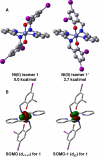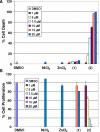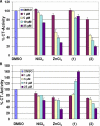Comparative activities of nickel(II) and zinc(II) complexes of asymmetric [NN'O] ligands as 26S proteasome inhibitors
- PMID: 19496541
- PMCID: PMC2878368
- DOI: 10.1021/ic900276g
Comparative activities of nickel(II) and zinc(II) complexes of asymmetric [NN'O] ligands as 26S proteasome inhibitors
Abstract
In this study, we compare the proteasome inhibition capabilities of two anticancer candidates, [Ni(L(IA))(2)] (1) and [Zn(L(IA))(2)] (2), where L(IA-) is the deprotonated form of the ligand 2,4-diiodo-6-(((2-pyridinylmethyl)amino)methyl)phenol. Species 1 contains nickel(II), a considerably inert ion that favors covalency, whereas 2 contains zinc(II), a labile transition metal ion that favors predominantly ionic bonds. We report on the synthesis and characterization of 1 and 2 using various spectroscopic, spectrometric, and structural methods. Furthermore, the pharmacological effects of 1 and 2, along with those of the salts NiCl(2) and ZnCl(2), were evaluated in vitro and in cultured human cancer cells in terms of their proteasome-inhibitory and apoptotic cell-death-inducing capabilities. It is shown that neither NiCl(2) nor 1 have the ability to inhibit the proteasome activity at any sustained levels. However, ZnCl(2) and 2 showed superior inhibitory activity versus the chymotrypsin-like activity of both the 26S proteasome (IC(50) = 5.7 and 4.4 micromol/L, respectively) and the purified 20S proteasome (IC(50) = 16.6 and 11.7 micromol/L, respectively) under cell-free conditions. Additionally, inhibition of proteasomal activity in cultured prostate cancer cells by 2 was associated with higher levels of ubiquitinated proteins and apoptosis. Treatment with either the metal complex or the salt was relatively nontoxic toward human normal cells. These results strengthen the current working hypothesis that fast ligand dissociation is required to generate an [ML(IA)](+) pharmacophore, capable of interaction with the proteasome. This interaction, possibly via N-terminal threonine amino acids present in the active sites, renders the proteasome inactive. Our results present a compelling rationale for 2 along with its gallium(III) and copper(II) congeners to be further investigated as potential anticancer drugs that act as proteasome inhibitiors.
Figures









Similar articles
-
Effects of tethered ligands and of metal oxidation state on the interactions of cobalt complexes with the 26S proteasome.J Inorg Biochem. 2011 Dec;105(12):1759-66. doi: 10.1016/j.jinorgbio.2011.09.013. Epub 2011 Sep 16. J Inorg Biochem. 2011. PMID: 22056177 Free PMC article.
-
Pristimerin induces apoptosis by targeting the proteasome in prostate cancer cells.J Cell Biochem. 2008 Jan 1;103(1):234-44. doi: 10.1002/jcb.21399. J Cell Biochem. 2008. PMID: 17541980
-
Inhibition of the 26S proteasome as a possible mechanism for toxicity of heavy metal species.J Inorg Biochem. 2014 Mar;132:96-103. doi: 10.1016/j.jinorgbio.2013.12.012. Epub 2014 Jan 8. J Inorg Biochem. 2014. PMID: 24452142
-
Metal complexes as inhibitors of the 26S proteasome in tumor cells.J Inorg Biochem. 2012 Jan;106(1):59-67. doi: 10.1016/j.jinorgbio.2011.09.003. Epub 2011 Sep 10. J Inorg Biochem. 2012. PMID: 22112841 Review.
-
Targeting proteasomal pathways by dietary curcumin for cancer prevention and treatment.Curr Med Chem. 2014;21(14):1583-94. doi: 10.2174/09298673113206660135. Curr Med Chem. 2014. PMID: 23834173 Review.
Cited by
-
Nickel and cadmium-induced SLBP depletion: A potential pathway to metal mediated cellular transformation.PLoS One. 2017 Mar 17;12(3):e0173624. doi: 10.1371/journal.pone.0173624. eCollection 2017. PLoS One. 2017. PMID: 28306745 Free PMC article.
-
Effects of tethered ligands and of metal oxidation state on the interactions of cobalt complexes with the 26S proteasome.J Inorg Biochem. 2011 Dec;105(12):1759-66. doi: 10.1016/j.jinorgbio.2011.09.013. Epub 2011 Sep 16. J Inorg Biochem. 2011. PMID: 22056177 Free PMC article.
-
Coordination chemistry suggests that independently observed benefits of metformin and Zn2+ against COVID-19 are not independent.Biometals. 2024 Aug;37(4):983-1022. doi: 10.1007/s10534-024-00590-5. Epub 2024 Apr 5. Biometals. 2024. PMID: 38578560 Free PMC article.
-
HIF-1α Upregulation due to Depletion of the Free Ubiquitin Pool.J Korean Med Sci. 2015 Oct;30(10):1388-95. doi: 10.3346/jkms.2015.30.10.1388. Epub 2015 Sep 12. J Korean Med Sci. 2015. PMID: 26425034 Free PMC article.
-
Inhibition of the purified 20S proteasome by non-heme iron complexes.Metallomics. 2012 Feb;4(2):174-8. doi: 10.1039/c2mt00131d. Epub 2011 Dec 15. Metallomics. 2012. PMID: 22170477 Free PMC article.
References
-
- Guo Z, Sadler PJ. Angew. Chem., Int. Ed. 1999;38:1512. - PubMed
-
- Wong E, Giandomenico CM. Chem. Rev. 1999;99:2451. - PubMed
-
- Wang D, Lippard SJ. Nat. Rev. Drug Disc. 2005;4:307. - PubMed
-
- Choi S, Vastag L, Larrabee YC, Personick ML, Schaberg KB, Fowler BJ, Sandwick RK, Rawji G. Inorg. Chem. 2008;47:1352. - PubMed
-
- Egger AE, Hartinger CG, Hamidane HB, Tsybin YO, Keppler BK, Dyson PJ. Inorg. Chem. 2008;47:10626. - PubMed
Publication types
MeSH terms
Substances
Grants and funding
LinkOut - more resources
Full Text Sources

